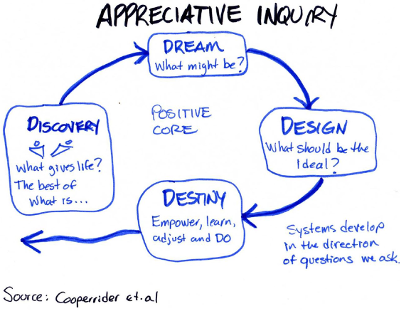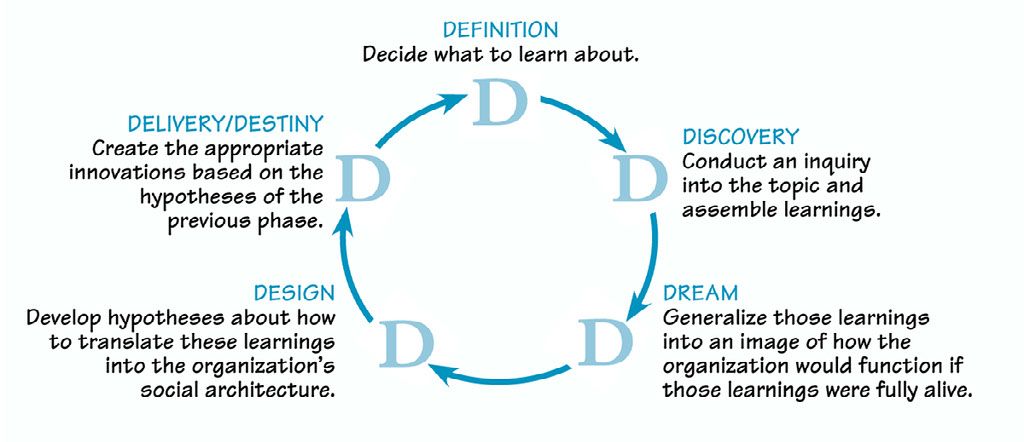Appreciative Inquiry
Experiential Education

Objectives
- What Appreciative Inquiry (AI) is and how it originated
- The principles and 4D cycle of Appreciative Inquiry
- How and why to apply the AI method for organisational development
- The benefits of using Appreciative Inquiry

As part of the Associate Degree programs at the University College, students will most likely draw on the Appreciative Inquiry (AI) methodology at some stage. This is because Appreciative Inquiry is widely used as an organisational development strategy in a range of contexts. If you are doing the Associate Degree in Agribusiness, Horticulture or Applied Business, it is highly likely you will need to know about, and use, AI. You will also use the tool/technique in other courses, and in the real world - in various settings and in different ways.
What is Appreciative Inquiry?
Appreciative Inquiry is a non-deficit process-based method for organisational transformation initiated by Cooperrider and Srivasa (1987); because they believed that the traditional models for organisational development were not suitable in post-industrial society (see Priest et al. 2013, p. 20). More specifically, according to MacCoy (2014, p. 105):
Appreciative Inquiry (AI) is a process of search and discovery designed to find the best in people, their organizations, and the world around them. As an organization development intervention, it is a collaborative, participative approach that involves asking questions to strengthen a systems capacity to heighten positive potential, generating new ideas and actions.
The method of inquiry is a tool often used in organisational development to identify and draw on ‘the positives’ for strategic planning and creating change. It involves discovering the best and then developing this further; guided by what practices the organisation and people do well.
The approach typically enables meaningful dialogue around organisational success (with the use of stories to begin conversations). This then leads to creative and innovative planning and action. So, a central idea in Appreciative Inquiry is that no matter what may be happening at any given moment in time, every organisation has a positive core.
What is the Positive Core?
- Strengths
- Peak experiences
- Successes
- Best practices, and
- Key learnings
It is essential that teams concentrate on the positive core and bring the best to the forefront. This is because the focus of Appreciative Inquiry is to draw on the strengths and successes of the organisation to create and innovate. It is not about concentrating on problems. This way the organisation builds on and transforms what it knows to be best practices when moving forward.
Appreciative Inquiry is a strengths-based approach to creating organisational change, that differs to the traditional or more dominant approaches that centre on problems, or weaknesses.
Ohlemacher (2015)

What are the Key Principles of Appreciative Inquiry?
There are five core principles of Appreciative Inquiry. The brief outline below of what these are is based on Jackie Kelm’s overview (see the YouTube video in the references list).
1. The Constructivist Principle: People co-create stories about what happens in their organisation at any given moment
2. The Poetic Principle: Organisations and their stories are like poetry and people can find and interpret whatever they want (including the good and the bad)
3. The Simultaneous Principle: Questions are a powerful tool for change
4. The Anticipatory Principle: People create mental pictures of the future in their minds which influences what happens
5. The Positive Principle: Focusing on the positive core creates change for the better
The video clip below provides more detail on the method and purpose of Appreciative Inquiry for students looking for greater depth:
Appreciative Inquiry | 3:45
The 4D Cycle in Appreciative Inquiry
Another important aspect of AI, is the 4D Cycle. As the term suggests, there are 4 key parts in the process itself - all starting with the letter 'D'. Below is a diagram of how the 4D cycle may be represented.

Change Management - Appreciative Inquiry
Change Management - Appreciative Inquiry
According to Ohlemacher (2015, p. 5 ) the 4D's include:
"Discovery, where people uncover what gives life to the organization; Dream, where people envision what might be possible; Design, where people translate the ideal into action; and Destiny, where people actualize their plans and determine how to sustain their success."
Bushe (2011, p. 2-4) extends on the the 4D’s so I have included some of this below for additional depth. Please note that Bushe (2011) draws on existing literature to explain these stages but rather than reference all of them here, I ask that you go to the article to look up any terms that are in inverted commas.
THE DISCOVERY STAGE
This is where people reflect on and talk about the topic of the inquiry – which, for example, might be the ‘life giving properties’ or ‘positive core’ of the organisation, or the ‘signature strengths of the organisation’. Sometimes the topic of inquiry might be about a process or organisational capacity. For instance, it could be about improving customer service. If it were, the teams might talk about what they believe to be the best experiences of their customers or even their own best experiences as a customer in other contexts. In practice, members of an organisation are usually interviewed or all stakeholders interview one another to draw on their ‘best of’ experiences.
THE DREAM STAGE
Organisational stakeholders are asked to think about dreams – so, if there were no barriers, what is the best that the organisation could be? People are asked to come up with shared aspirations for the organisation and a way of symbolising this. Rather than mission statements, participants are asked to construct a visual representation that carries meaning.
THE DESIGN STAGE
Once the shared aspiration or vision is decided upon, the members of the organisation are asked to come up with proposals that frame up the new state of the organisation, or what Cooperrider called ‘provocative propositions’. These may also be called ‘possibility statements’ or ‘design statements’ and often lead into prototyping activities under particular themes.
THE DELIVERY/DESTINATION STAGE
This was originally called the Delivery stage by Cooperrider but he later changed it to Destination because the word Delivery could be easily associated with traditional change management theories; the very thing that AI was designed to avoid becoming/being. In this stage, stakeholders are to create new targets, and objectives and look at gaps to fill based on the outcomes from the design stage.
A FIFTH DIMENSION
In recent times, a 5th dimension was added at the beginning with some arguing it is the most important part of the cycle. This is Define – So, this is the first stage where you articulate what the topic of inquiry is. According to Mohr (2016), this phase is arguably the most important one in the AI cycle, because it establishes the initial focus and scope of the inquiry. When the 5th element is added, the diagram is more like this:

Systems Thinker
Systems Thinker
The links below will take you to more on Appreciative Inquiry, largely building on what has been presented above. So, more on definitions, principles and the 4D cycle but also on the application of AI as a method of inquiry.

Application of Appreciative Inquiry
Appreciative Inquiry is used in a range of contexts typically if problem-based or deficit approaches aren’t the right choice. For example, problem based approaches are generally effective in situations where an existing issue exists that can be fixed, but not overly useful for exploring what is working well and extending on this. For example, Appreciative Inquiry has been used largely in:
- Change management
- Strategic planning
- Organisational design and development
- Team building
- Performance review
- Leadership development
- Coaching
- Research
- Conflict resolution
- Development aid programs
- Leadership development initiatives, and
- Staff development programs
MacCoy (2014, p. 106)
BENEFITS OF APPRECIATIVE INQUIRY
As the method is grounded in discovering the positives and successes rather than identifying problems; it is a powerful tool for generating desires in people to change. According to WHRA (2013 p. 2 - this is a direct excerpt/quote), some of the benefits of AI, are that it:
- Accelerates change of all kinds
- Increases the rate of improvement and the speed of attainment of goals and results
- Creates motivation and energy amongst the people who are changing
- Improves communication, trust, understanding and relationships
- Contributes to team building, and discovers, expands and sustains the best of what an organization can offer
- Changes the basic orientation from problem-focused to possibility-focused
- Increases curiosity and sense of vitality
- Empowers and gives people the confidence to take risks
Activity
To consolidate your understanding of Appreciative Inquiry go to the engagement activity in PebblePad. Once completed it will be saved in your Asset store. You can then move it into one of your Porfolios (e.g. Professional or Unit) .
Summary
This method of inquiry is grounded in the belief that it is critical to explore strengths for transforming organisations and leading change – not problems. It is about identifying ‘pockets of excellence’ rather than deficits and then using that information to plan and introduce innovations for change (Holland-Fiorentino, 2012).
AI is based on discovering what is working, what gives life, what is creating energy and excitement, and then determining how to create more of it.
Traditionalists in the field of organisational development tend to use the SWOT approach (Strengths, Opportunities, Threats and Weaknesses), however AI is more about analysing Strengths, Opportunities, Aspirations, and Results to inform or create change. Rather than compare one approach with the other, we encourage you to embrace or draw on the one you see most appropriate depending on the context.
To summarise, Appreciative Inquiry focuses on exploring the positive core. So, what are the strengths of the company? Peak experiences? Successes? Best practices? Key learnings? From there, it is about considering how you can generate meaningful dialogue around these. The story telling and narrative around the company’s positives and successes may then be drawn on to inform future action. This way of thinking encourages people to use the best of what they already do, and have, and build on it. It takes the focus away from ‘identifying problems’ and onto ‘identifying strengths/positives’.

References
Bushe, G R 2011, Appreciative inquiry: Theory and critique. In Boje, D, Burnes, B and Hassard, J. (eds.) The Routledge Companion To Organizational Change (pp. 87-103). Oxford, UK: Routledge.
Cooperrider, D & Srivasa, S 1987, 'Appreciative inquiry in organisational life', Research in Organisational Change and Development, vol. 1, pages 129-169.
Cooperrider, DL & Whitney, D, 'Appreciative Inquiry: A positive revolution in change.' In P. Holman & T. Devane (eds.), The Change Handbook, Berrett-Koehler Publishers, Inc., pages 245-263.
Holland Fiorentino, L, 2012, 'Positive perspectives on the profession: Reframing through appreciative inquiry, Quest, vol. 64 no. 4, pages 209-228.
MacCoy D I, 2014, ‘Appreciative inquiry and evaluation: Getting to what works’, Canadian Journal of Program Evaluation / La Revue canadienne devaluation de programme, vol. 29 no. 2.
Ohlemacher, J 2015, ‘Fostering meaningful dialogue can improve success in learning’, Assessment Update, vol. 27 no. 2, viewed 1st November 2017, http://onlinelibrary.wiley.com/doi/10.1002/au.30015/epdf
Priest, K L, Kaufman, E K, Brunton, K & Seibel, M 2013, ‘Appreciative inquiry: A tool for organizational, programmatic, and project-focused change’, Journal of Leadership Education, vol. 12, no. 1.
Other Resources
<https://www.youtube.com/watch?v=ZwGNZ63hj5k)>.
<https://tobyelwin.com/change-management-appreciative-inquiry/>.
<https://thesystemsthinker.com/appreciative-inquiry-igniting-transformative-action/>.
<http://www.wrha.mb.ca/staff/collaborativecare/files/AppreciativeInquiry2013.pdf>.
<https://www.slideshare.net/johnrg/appreciative-inquiry-4472991>.
Developed for the Practice and Portfolio Program for the Associate Degrees, University College, by Dr Cherie Hawkins, 7th November 2017.

